Tandem BASE Jumping:
The Complete History
Written By Robin Heid November 9, 2023
Introduction
Tandem BASE jumping is a form of sport parachuting where two people jump with a single parachute system from a fixed object such as a building, antenna tower, bridge, or cliff.
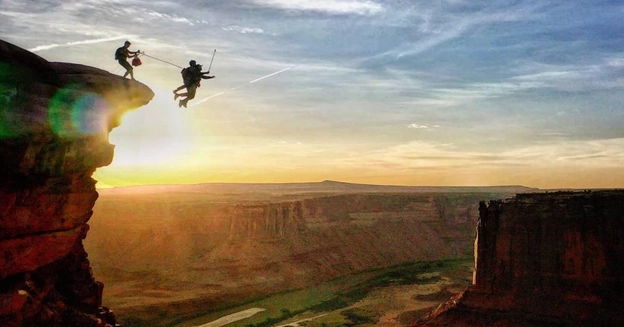
Tandem parachuting started in 1977, when Jim and Dana Handbury took their 11-year-old son Kirk on a skydive after building a special harness for him that attached to the parachute-carrying jumper’s regular skydiving harness.
Tandem BASE began in 1984, when tandem parachute system designer Ted Strong and veteran BASE jumper Robin Heid parachuted from the railing of the 876-foot-high New River Gorge Bridge in West Virginia.
Before, between, and after these two events, a lot happened to make both tandem parachuting and tandem BASE jumping a well-known and integral discipline among the many that make up sport parachuting.
Origins
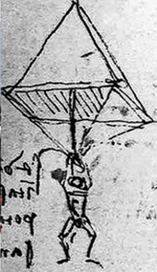 Even many non-parachutists know that Leonardo Da Vinci designed the first parachute, a wooden and fabric contraption he sketched into a notebook in 1485. This sketch now resides in the Codex Atlanticus, a 12-volume collection of Da Vinci’s drawings and writings that address subjects from flight to weapons to musical instruments and mathematics. It is unlikely that Da Vinci actually tested his pyramid-shaped parachute, about which he wrote:
Even many non-parachutists know that Leonardo Da Vinci designed the first parachute, a wooden and fabric contraption he sketched into a notebook in 1485. This sketch now resides in the Codex Atlanticus, a 12-volume collection of Da Vinci’s drawings and writings that address subjects from flight to weapons to musical instruments and mathematics. It is unlikely that Da Vinci actually tested his pyramid-shaped parachute, about which he wrote:
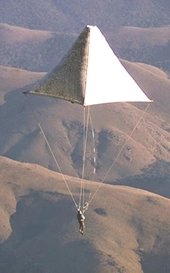 Se un uomo ha un padiglione de pannolino intasato, che sia 12 braccia per faccia e alto 12, potrà gittarsi d’ogni grande altezza senza danno di sé. (If a man has a structure made out of coated cloth 12 arms wide and 12 tall, he will be able to throw himself from any great height without hurting himself.)
Se un uomo ha un padiglione de pannolino intasato, che sia 12 braccia per faccia e alto 12, potrà gittarsi d’ogni grande altezza senza danno di sé. (If a man has a structure made out of coated cloth 12 arms wide and 12 tall, he will be able to throw himself from any great height without hurting himself.)
British parachutist Adrian Nicholas proved 515 years later that Da Vinci’s design worked. He built a wood and canvas parachute to the old artist’s specifications, then jumped with it in June 2000 from a balloon 10,000 feet above Mpumalanga, South Africa. Nicholas said the ride was smooth and that it descended slowly enough to land, but he feared the 185-pound parachute would collapse onto him, so he jettisoned it at 2,000 feet and landed under a modern parachute.
Eight years later, Swiss jumper Olivier Vietti-Teppa repeated the feat, this time following Da Vinci’s design but using modern materials. Like Nicholas, he also wore a modern parachute in case the now 523-year-old design didn’t work, but it performed flawlessly and he landed it safely.
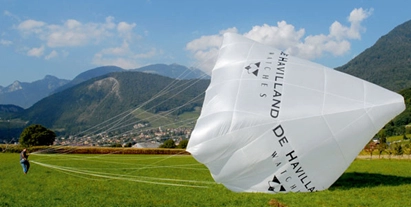
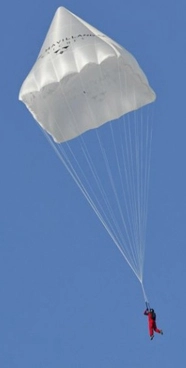
First jumps: 1783 – 1900
No one knows for sure when the first successful parachute jump was made. Croation Faust Vrančić, for example, definitely designed a parachute based on Da Vinci’s design, and reportedly tested it successfully from a tower in Venice, Italy, in 1617, but there is no evidence that he actually jumped it.
 The first witnessed jump was a BASE jump, made in late 1783 by Frenchman Louis-Sébastien Lenormand, who descended safely from a tree using two modified umbrellas.
The first witnessed jump was a BASE jump, made in late 1783 by Frenchman Louis-Sébastien Lenormand, who descended safely from a tree using two modified umbrellas. He then tweaked his design a bit and on December 26 jumped again, this time from the tower of the Montpellier observatory using just one 14-foot parachute with a wooden frame. This was not only another BASE jump, it was the first-ever parachute demonstration jump, as a large crowd watched his feat. Lenormand is also credited with naming the device a parachute, from the Latin prefix para meaning "against," and the French word chute for "fall."
He then tweaked his design a bit and on December 26 jumped again, this time from the tower of the Montpellier observatory using just one 14-foot parachute with a wooden frame. This was not only another BASE jump, it was the first-ever parachute demonstration jump, as a large crowd watched his feat. Lenormand is also credited with naming the device a parachute, from the Latin prefix para meaning "against," and the French word chute for "fall."
The next big step in parachuting happened in the early 1790s, when French balloonists decided it was a good idea to have a backup plan in case their balloon failed. Wooden-frame parachutes were too big and heavy, so balloonist Jean-Pierre Blanchard built a parachute made only of silk, which was not only lighter but stronger – and could be folded into a compact size. Blanchard successfully tested the silk parachute on a dog, then used it himself in 1793, when his own hot-air balloon disintegrated.
Next to jump was André-Jacques Garnerin, who in 1797 also used a non-rigid parachute attached to a gondola that he released from a balloon approximately 8,000 feet above the ground. Two years later, his wife Jeanne Geneviève Labrosse, repeated his descent and became the first woman to make a parachute jump. The Garnerin parachute was 30 feet in diameter and made of canvas.
Parachuting continued at an inventor and daredevil level for more than 100 years, but while there is little documentation of actual jumps made during that period, there were notable advancements in parachute technology – and one tragic first.
In 1837, Robert Cocking became the first person to die in a parachuting accident. Fifty years later, Captain Thomas Baldwin invented and built the first harness to which a parachute could be attached. Three years after that, Paul Letteman and Kathchen Paulus figured out how to pack a parachute into a backpack attached to a parachute harness, thus creating the first complete parachute system.
Parachutes as Tools for War and Fun: 1901 – 1959
Then came the 20th century, and the use of parachutes for emergencies and fun began in earnest. 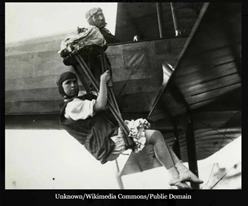 Charles Broadwick, Leslie Irvin, Gleb Kotelnikov, Albert Leo Stevens, and Solomon Lee Van Meter, Jr., worked separately on their own variations of parachute harness-container systems, some using static lines attached to the plane to start deployment, others using a ripcord for deployments without aircraft assistance.
Charles Broadwick, Leslie Irvin, Gleb Kotelnikov, Albert Leo Stevens, and Solomon Lee Van Meter, Jr., worked separately on their own variations of parachute harness-container systems, some using static lines attached to the plane to start deployment, others using a ripcord for deployments without aircraft assistance.
In 1911, both Grant Morton and Captain Albert Berry parachuted from an airplane (though it’s not known which man did it first). Three years later, Georgia "Tiny" Broadwick became the first person ever to make a freefall parachute jump, an achievement that led to the creation of emergency parachutes for World War I airplane and balloon aircrews. World War I also saw the first use of parachutes as a military insertion method. During early August 1918, Italian Army saboteurs Alessandro Tandura, Ferruccio Nicoloso, and Pier Arrigo Barnaba jumped at night from 1,600 feet into Austro-Hungarian lines near Vittorio Veneto.
Two years after the war ended in 1918, Stanley Switlik founded the Canvas-Leather Specialty Company. It first made leather hampers, pork roll casings, and a variety of bags. Then Switlik started making pilot and gunner belts, flight suits, and parachutes. He soon renamed the company Switlik Parachute & Equipment Company and, in 1934, partnered with famed aviator Amelia Earhart’s husband George Palmer Putnam to build a 115-foot tall tower for training airmen how to jump. Ms. Earhart herself made the first public jump from the tower on June 2, 1935, in front of reporters and officials from the Army and Navy. Earhart described her jump as "loads of fun!"
The next big development in parachuting came in the same decade, when the German, Soviet, and U.S. militaries began developing airborne forces of several thousand men. The Soviets were the first to make large-scale drops of several hundred men; the Americans followed suit with their own variations, one of which included bicycles and Thompson submachine guns.
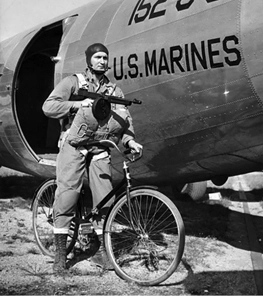 The first airborne combat jump was made by German paratroopers, who in April 1940 seized Denmark’s Aalborg Airport and several nearby bridges. In 1942, Japanese, Soviet, British, and American paratroopers all conducted airborne assaults, and, in 1944, a then-unprecedented 20,000 U.S. paratroopers jumped into German-occupied France the night before D-Day, June 6, 1944. Several months later, a combined British-U.S. force of 16,000 paratroopers jumped into Germany itself to leapfrog the Rhine River
The first airborne combat jump was made by German paratroopers, who in April 1940 seized Denmark’s Aalborg Airport and several nearby bridges. In 1942, Japanese, Soviet, British, and American paratroopers all conducted airborne assaults, and, in 1944, a then-unprecedented 20,000 U.S. paratroopers jumped into German-occupied France the night before D-Day, June 6, 1944. Several months later, a combined British-U.S. force of 16,000 paratroopers jumped into Germany itself to leapfrog the Rhine River
The Sport Begins: 1946 - 1976
When the war ended, tens of thousands of ex-paratroopers went back to civilian life, and a good number of them wanted to keep jumping because, well, they loved it. On top of that, there were now thousands of military surplus parachutes in circulation. They were heavy and ugly, but they were safe and easily available, and you could buy a complete setup for the price of a 6-pack.
Thus did sport parachuting began, with ex-paratroopers showing up at small airports with their parachutes seeking to talk local pilots into taking them for a ride. Most pilots thought the ex-paratroopers were crazy: They weren’t jumping to put on a show or make money, they were doing it just for fun. So at first most pilots wouldn’t fly them (though to be fair, most pilots didn’t cotton to barnstormers, either), but those who did reported that jumping for fun was a repeatable and reasonably safe activity. As a result, pilots and aircraft owners realized they could make money by taking these crazy guys (and occasional girls) for a one-way airplane ride without even getting out of power-out glide range of their home airport.
Soon, small clubs formed, composed of members who used several different dues- or per-jump-based systems to pay for pilot, airplane, and, in some cases, hangars or clubhouses. Despite these advances, sport parachuting remained a niche activity, mostly because there was no real training system for new jumpers, and no formal association to organize it.
This situation changed radically in the 1950s, mostly due to one man: Jacques Andre Istel, a French-born American and former U.S. Marine Corps lieutenant colonel who had served in the Korean War. Istel made his first jump in 1950, then within a few years established the Parachute Club of America (PCA), the first private parachute company, the first commercial parachute centers, the Intercollegiate Parachuting League, Parachutist Magazine, and a training system that adapted the week-long US paratrooper training regimen into a one-day first-jump course. Several decades later, Istel described his training system in an interview with the magazine he founded:
"The Army took several days to train for the first jump. I taught my students in 45 minutes, and I only taught five things: How to exit the aircraft, check your canopy, emergency procedure, how to land, and how to collapse your canopy after landing. A first jump is a scary occasion. Principle: Teach as little as possible, emphasize five vital points."
With Istel and fellow parachuting pioneers Lew Sanborn and Joe Crane leading the way, more commercial parachuting centers opened, more parachuting manufacturers opened for business, the PCA grew into the U.S. Parachute Association, Most parachuting centers operated 4- to 6-place single-engine Cessnas. Then the centers, known as "drop zones" to their clientele, started adding 10-place Beechcraft 18s, then 40-place DC-3s and other larger aircraft. By the mid-1970s, the bigger drop zones began converting their fleets of aging piston-powered aircraft to more modern turbines, chief among them being the rugged 23-place DeHavilland Twin Otter. At the same time, the drop zones themselves were upgrading their facilities, with the largest becoming more like resorts than the dusty fields with porta-potties that were the norm during the sport’s early days.
Parachute designers were busy, too, first developing round parachutes with higher performance than military surplus parachutes, then to wing-type parachutes that were an order of magnitude faster, more maneuverable, and nicer to land.
At the same time container manufacturers moved from fancier versions of over-built military surplus systems to smaller, lighter more streamlined versions that put both main and reserve parachutes on the jumper’s back.
One of those manufacturers was Jim Handbury, a southern California jumper who started building "Handbury rigs" in the 1970s. Handbury’s wife Dana was also a jumper and, in 1977, their then-11-year-old son Kirk decided he wanted to jump, too.
Let the Tandems Begin: 1977 - 1983
This confluence of capability and desire led to the first known tandem parachute jump. Jim built a Kirk-sized harness for his son that attached to the main lift web of the parachute-carrying jumper’s harness. When Kirk’s 11th birthday arrived – June 11, 1977 – Jim and Dana boarded the plane with Kirk attached to their friend Mike "Beanpole" Barber, with photographer Charlie McGurr along to chronicle the event. The jump went off without a hitch, though Dana said later that her heart was in her throat watching her young son in freefall.
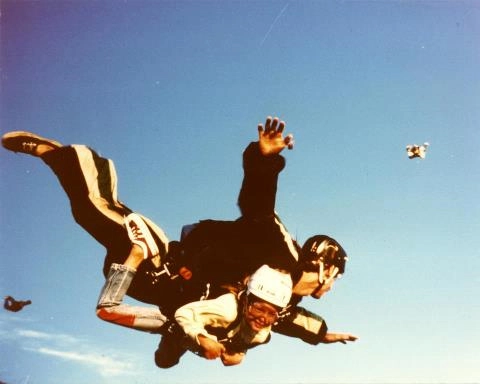
Kirk made a few more jumps, this time with his dad, before retiring from the sport with a new moniker: "Sky Kirk."
After Handbury proved that tandem parachuting worked with lightweight passengers, several more child tandems were made, including a few made by Roger Nelson with his kids, Melissa and Rook. Melissa went first, in 1982 at age 5; little brother Rook went a year later at age 4.
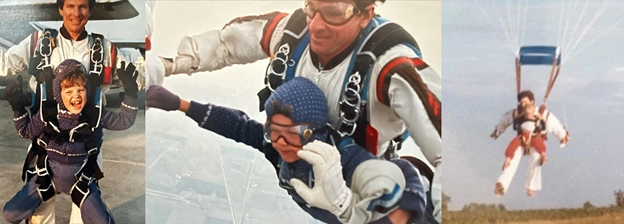
The First Tandem BASE Jump
By 1984, Strong had a working tandem rig, which he and Bill Morrissey demonstrated to parachute centers around the U.S. Then came the third weekend in October and the New River Gorge Festival in West Virginia. The 2-day event featured several hours of BASE jumping on Saturday, when hundreds of jumpers stepped off the 876-foot-high span.
Ted showed up with his tandem rig and asked for volunteers. One military guy was interested, then disappeared, so Ted went looking for somebody else to go with him. He ran into his friend Robin Heid, who was BASE 44 and at the time one of the more experienced BASE jumpers in the world with… 20-something BASE jumps.
Robin said he’d be happy to go, but he wanted to watch Ted jump by himself first (Ted had thousands of jumps but only a few BASE jumps. Ted did a decent launch using a hand-held BASE pilot chute, and the rest of the jump went flawlessly, so Robin agreed to go.
"Ted was a little head low on his solo jump," Robin said later, "so I knew I had to thrust straight upward into his chest to keep us from going vertical. Otherwise, he was fine, so I was good to go."
The launch went exactly as planned, with Robin pushing up at launch and the pair going slightly head-down a moment later. Ted pitched pilot chute at 3 seconds and then, using his decades of accuracy competition experience, center-punched the sandbar landing area. Later, many jumpers asked Robin how he could trust his life to someone else on a BASE jump."
"I told them that Ted Strong was the most reliable piece of parachute equipment I’d ever jumped with," he said after the jump. "He’s worked flawlessly more than five thousand times, and he has an automatic self-preservation mode. No worries!"
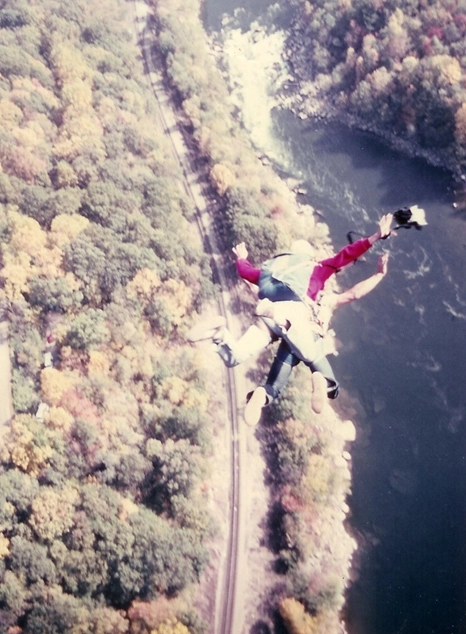
1985 – 2010 More Tandems, Fewer Tandem BASE Jumps
Not long after the first tandem BASE jump, Strong and fellow legendary parachute system manufacturer Bill Booth fielded commercially viable tandem systems, and this new way of enjoying a parachute jump took the skydiving world by storm. Thousands of tandem jumps were made in the early years, then tens of thousands. Today, hundreds of thousands of tandem jumps are made worldwide each year, using Strong and Booth systems, plus systems made by several other U.S. and foreign manufacturers.
Tandem BASE jumping did not immediately become a commercial activity, however. This was due in large part to the facts that BASE jumping is far more dangerous than skydiving from a plane, there were approximately 50 parachutists for every BASE jumper, and few people in the general population are bold enough to make a tandem jump from an airplane, much less from a cliff or bridge. Tandem BASE jumps continued to be made all over the world, but they were always one-off adventures for fun. No one thought of making it into a business.
Tandem BASE jumping Goes Mainstream: 2010
That changed in 2010, when Idaho jumpers Mark "Tree" Kissner (manufacturer of the Huck-It BASE Rigs) and Abbie Mashaal (founder of DZONE® Skydiving) decided there was indeed a market for tandem BASE jumping. Both lived in Twin Falls, home of the 486-foot-high Perrine Memorial Bridge, where jumpers from all over the world came to jump legally 365 days a year. There was also a cottage industry of first-jump BASE courses being offered by a variety of jumpers of varying skill, experience, and teaching ability.
"Tree and I were sitting in his shop one day, complaining about the horrible BASE instruction out there," Mashaal remembers. "A local instructor and his nonsense, plus all these money-hungry poseurs hawking 2-day courses that might be adequate for bridges like Perrine but completely unacceptable for the more dangerous BASE jumps from buildings, cliffs, and even antennas. We were disappointed that BASE instruction was going rip-off commercial rather than evolving along the mentorship route of its earlier days. That's when the lightbulb went off and we said, ‘If BASE is going commercial, let’s go all the way – we'll just start taking tandems off the bridge!’ And sure enough, we did."
Abbie and Tree, however, did not follow in the footsteps of the mostly (but not always) sketchy BASE training being offered at Perrine; both had business backgrounds, so they approached the project as a business venture intended to create an outstanding product and experience.
The first thing they did was organize TandemBASE LLC with the Idaho Secretary of State. Next up: Liability concerns. Abbie and Tree worked closely with Twin Falls Chamber of Commerce President Sean Barigar to make sure the city was clear about their plans. They were also aware of the impact a tandem BASE fatality or injury could have on legal jumping at the Perrine, so they wanted to cover all their bases.

Abbie then contacted Robin Heid to write a proposal for the Idaho state government that would further protect them from lawsuit-happy customers. Robin, who in addition to being a long-time BASE jumper was also a professional journalist and political consultant, wrote a draft jumper liability law based on tried-and-true Colorado skier and horseback riding liability laws. Abbie and Tree hoped for it to become state law, but they started first with the city of Twin Falls. In December 2010, they presented their proposed legislation to the city council. The council was not interested in making it a law, but they gave their support to the tandem BASE project. Abbie and Tree also lobbied for passage of their proposed law at the Idaho legislature, but their efforts failed due to unrelated political trauma that essentially shut down the legislature that year.
Next came policies and procedures. Abbie already owned and operated two parachute centers, so he had an understanding of what support documentation would be needed for TandemBASE. Standard operating procedures (SOPs) were written for every aspect of TandemBASE, from gearing up the customer to getting them over the bridge rail into launch position (using a two-tether safety system to make sure everyone stayed secure until they were ready to jump). They decided, that, while they could copy the liability waiver Abbie used for tandem skydiving, it made more sense to hire an attorney who developed one to fit the comapany’s needs.
At the same time, Abbie and Tree developed BASE-specific tandem equipment, as the available tandem gear was not suitable for BASE, and the available BASE gear was not suitable for tandems. There were three elements they needed to create:
- 1) The tandem BASE container system
- 2) The tandem BASE parachute
- 3) A tandem BASE launch platform big enough for three people that would attach to the Perrine Bridge
The Tandem BASE Container System
Tree had manufactured his Huck-It line of BASE harness-container systems for several years, so he designed and manufactured the first Huck-It DUO tandem BASE rig. The system incorporated elements of a tandem skydiving rig and a Velcro-closed BASE rig. Tree beefed up DUO to match the strength built into a tandem skydiving harness/container, and added tandem attachment rings. He similarly based his customer harness on the already-proven designs made by tandem skydiving manufacturers. He went with Velcro closure for main container because that was also a proven system for short-delay BASE jumping.
"Given how we were pushing the boundaries of BASE with tandem BASE," Tree explained, "we wanted to stay with the most tried and true equipment possible."
After the DUO was ready, Abbie and Tree hoped to put an off-the-shelf BASE canopy into it. They asked around and discovered that Apex BASE had built a 344-square-foot Flik for a large customer who had then declined to buy it. They bought it and in the fall of 2010, Tree attached a 50-pound bag of sand to his new Huck-It DUO rig and jumped with it via pilot chute assist (PCA) from the Perrine Bridge. That first jump went off without problems, and was followed by similar sandbag and concrete "passenger" PCA jumps made by Tree, Brent "Idaho" Clark, and Sean Chuma.
They soon discovered that two elements needed adjustment: The container system closure method, and the canopy size.
"After working with the Velcro-closed system for a while," Tree said, "we realized that the much larger tandem BASE canopies needed the closure strength of a pin-closed system, so we switched over to a 2-pin design for the finished version."
They also discovered that the Flik 344 was not suitable for tandem BASE for two reasons: It was not big enough for the weight it had to support; and its lower aspect ratio configuration did not provide enough flare power for consistently good landings.
The Tandem BASE Parachute
Though Abbie and Tree initially used the 7-cell Flik 344 because it was available, Abbie had always thought they needed 9-cell construction which allowed for an aspect ratio similar to tandem skydiving parachutes already on the market. The test jumps by Tree, Idaho, Chuma and a few other BASE jumpers confirmed that Abbie’s analysis was correct, so they went in search of a more suitable canopy.
"We were turned down by the tandem skydiving manufacturers," Abbie said, "even though all I was asking for was an existing canopy (a particular tandem reserve) with a beefy bridle attachment point added to it. So, next I went to the BASE manufacturers; I’d figured out a design technique that would have minimal impact on a manufacturer's current patterns, processes, and workflow. You see, BASE canopies are built using cell-wise construction with no taper; seven identical cells are built and then sewn together. I did some simple calculations and found that if we took a current manufacturer's 300-ish 7-cell and sewed another cell to each side, we’d have a canopy that met our square-foot and aspect ratio requirements."
Abbie then reached out to Marty Tilley, owner of Asylum BASE. Abbie had used Asylum gear almost exclusively for BASE jumping, and had even spent a couple of winters being Marty’s apprentice. Marty did not have the bandwidth to expand into other areas, however, so Abbie contacted Todd Shoebotham at Apex. Todd agreed to build a prototype, and the result was a 9-cell, 375-square-foot canopy with an aspect ratio almost identical to tandem skydiving canopies. Abbie and Tree dubbed it the TBX.
"We tested it and made several line changes in the field as we learned more on each jump," Abbie said. "When we were satisfied that we had an acceptable configuration, we told Todd we needed to make a few design changes but that we were ready to place a production order." Unfortunately, Todd instead asked Abbie and Tree to return his prototype, and told them their production order would have a lead time of one year.
"I believe we were sitting in Tree’s shop when this happened," Abbie recalled, "so I decided to call Stane Kranjc with Atair, in Europe. I knew he’d get it – and he did. His first response was that he didn't have time to design anything new. I said ‘Wait wait wait, just listen, I want you to take your Troll 305 pattern and slap two extra cells on it’ – and before I’d even finished explaining it, he stopped me and said ‘and then we just have to trim it steeper!’ Stane was clearly the right guy for the job; he knew instantly what we were doing – to the point that he nailed the line length and trim on the first shot. That was so cool!"
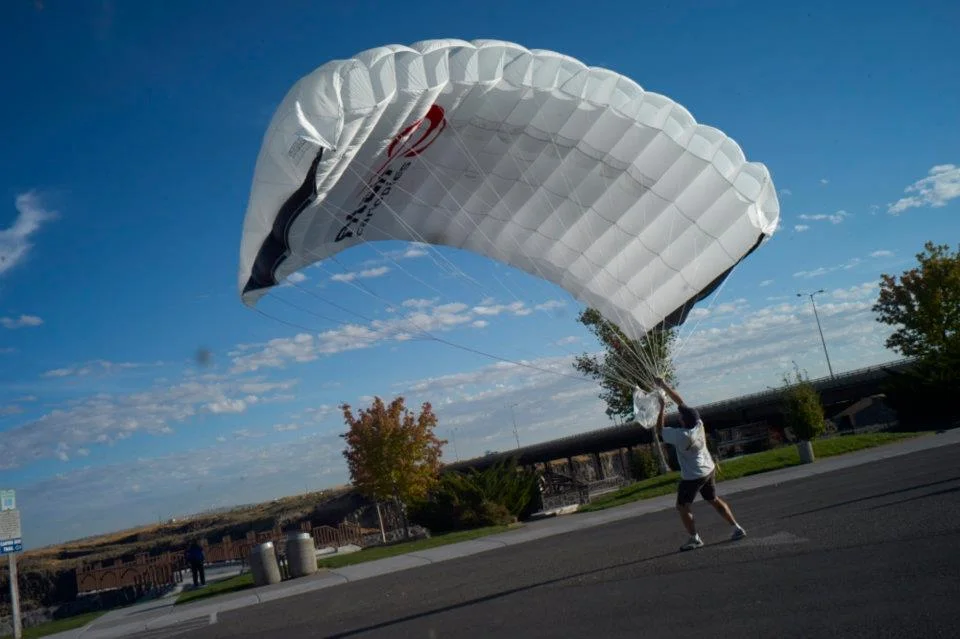
Thus, the TBX-385 was born. Tree then called up Troy Widgery at Go Fast Sports and offered him the opportunity to fund the first TBX. Like Stane, Troy saw the potential instantly and sponsored the canopy with a full-size Go Fast logo. Stane followed up by sponsoring the second canopy.
The Tandem BASE Launch Platform
Detachable jump platforms had been used at the Perrine Bridge for years, but a jump platform for TandemBASE had to be specially designed and engineered. In particular, tandem pilot and customer could not climb over the bridge railing already connected, an element not present for solo jumpers. The platform had to be small enough to be easily carried out onto the bridge, set up, and then taken down immediately so as to not impede pedestrian traffic. Tree designed it to safely and comfortably accommodate three people (jumper, customer, and static line manager). Tree built the platform in his shop, and it remains in use 13 years later.
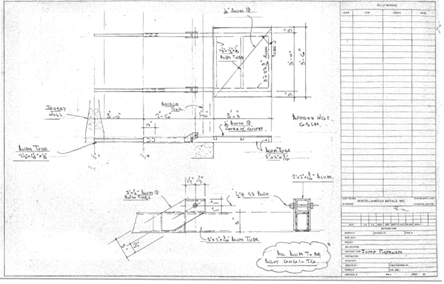
Let the Tandem BASE Jumps Begin
Some test jumps were made with sand bags or concrete, but a few test jumps were made with human passengers. The first was Heather, a woman related to a local jumper. With Tree handling the PCA duties, Heather took the plunge with Sean Chuma!
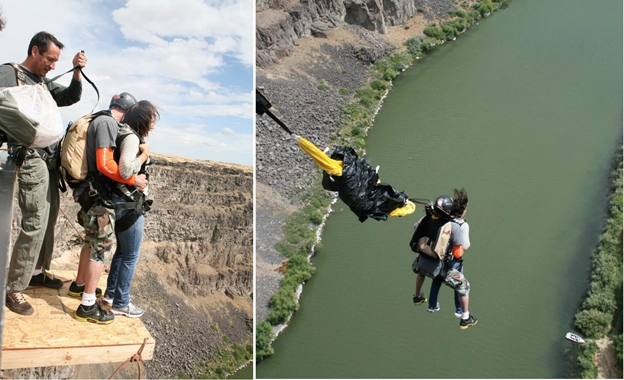
Other local test jumpers followed, and then came their first paying customer – a German man who flew in from Europe to make his jump after finding the TandemBASE website on the internet.
Several other paying customers followed in early 2011, and all jumps were completed successfully and with no surprises. Abbie and Tree decided they were ready for prime time, so Tree called Jason Bell, who ran the BASE jumping operation at the annual New River Gorge Bridge Festival. Tree was also a staffer at the event, and both he and Jason presented the idea of tandem BASE jumping to the Bridge Day Commission, which voted to allow it at Bridge Day 2011. TandemBASE pilot Mark Kruse took the first of commercial customer that year, followed by ten more. An average of 15 tandem BASE jumps have been made at New River every year since then.
"It’s become an integral part of Bridge Day that the spectators really enjoy," Tree said. "It adds to the experience for everyone."
Passing the Tandem BASE Torch
Late in 2011, Abbie moved his business two hours west of Perrine to Star, Idaho, near the much larger market of Boise and spent much of his time there growing that operation. The move was also made because tandem BASE did not grow as much as Abbie and Tree thought it would. They envisioned doing 1,000 or more tandem BASE jumps every year, but there was far less interest than they expected. Fortunately, while Abbie and Tree had invested a lot of time and sweat equity in creating tandem BASE jumping, they had not invested a lot of money in the business, so Abbie gifted his half of the business to Tree on a handshake. Within the year, Tree sold his Twin Falls businesses and moved with his wife and three kids back to his home state of Maryland. Tree also followed Abbie's gifting move and gifted TandemBASE LLC in toto to their lead instructor and friend Sean Chuma, in hopes that he would keep the business alive and growing. Abbie and Sean codified Abbie’s shares with a purchase agreement between them for one dollar, which Sean paid with four quarters. The two of them are jokesters and both enjoyed that moment. Abbie still has the four quarters.
Past, Present, and Future
Since Chuma's acquisition of TandemBASE LLC, he has purchased a few more canopies from Atair, had Nick Burden build some copies of Tree's Huck-It DUO container, and continues to provide tandem BASE jumps every year at Bridge Day. Chuma makes between 50 and 100 tandem BASE jumps each year. Several other people are also doing tandem BASE jumps at the Perrine, and Moab BASE jumper Matt Lajeunesse started a tandem BASE operation in 2021 in Moab, Utah.
Where tandem BASE goes from here is anybody's guess. Like BASE jumping itself, tandem BASE is a small sub-discipline within the also-small sport of parachuting. There will never be thousands of people yearning to huck themselves from a bridge or a cliff attached to someone they met the hour before. However, it does seem that TandemBASE provides an opportunity for a small but steady stream of daring individuals to taste the joy and thrill of jumping from a fixed object - and living to tell lies about it. It was with those people in mind that Abbie and Tree created TandemBASE, and seeing the continuing enjoyment of those who take advantage of their creation brings them both a lot of satisfaction.